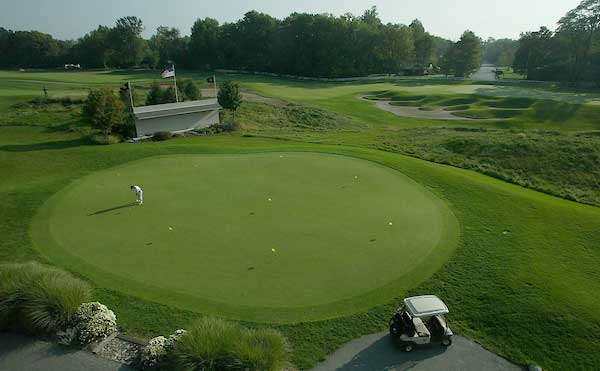Building a Backyard Putting Green (AGRY-98-01) (AGRY-98-01)
Purdue Extension Publication

Photo Courtesy of Purdue Agricultural Communication
Location
- Full sun – The green should be located in full sun for optimum turf growth and performance.
- Air movement – Locate the green so the wind (air flow) is not blocked by trees or buildings.
- Do not locate the green in a depression or low area.
Construction
- Surface drainage – Contours on the green should facilitate rapid surface drainage water.
- Do not create any pockets or low areas where water will stand. Water should drain off the green in more than one direction.
- Rootzone – Almost any soil would be suitable for building a backyard putting green. A sandy loam soil would make an ideal rootzone. Traffic and wear on a backyard putting green is so limited it does not make sense to haul in sand or other material to create a special rootzone mix.
- Grass – Creeping bentgrass is the recommended grass species for putting greens. The seeding rate is 0.5 lb seed per 1,000 sq. ft. Creeping bentgrass seed can be purchased from seed supply houses.
Maintenance
- Mowing – The green should be mowed at 3/16 to 1/4 inch four or more times per week.
- Fertilization
- Fertilize the green with 0.5 lb nitrogen per 1,000 sq. ft. on May 1 and June 1.
- Fertilize with 1.0 lb nitrogen per 1,000 sq. ft. on Sept. 15 and Nov. 15.
- Irrigation – Water the green in the early morning (5-7 a.m.) hours. Only water when the green shows signs of drought stress.
- Pests – Several insects and diseases are potential pests of creeping bentgrass greens. The first step in pest control is to produce a dense, actively growing stand of grass.
- Topdressing – Topdressing is the application of a thin layer of soil on top of the putting surface. Apply a layer of topdressing approximately 1/8 inch thick of screened soil to putting surface. Use a push broom to work the topdressing down through the turf canopy. Apply topdressing in early May and late September.
Additional Source
- Turf Management for Golf Courses by James Beard. Burgess Publishing, Minneapolis, MN